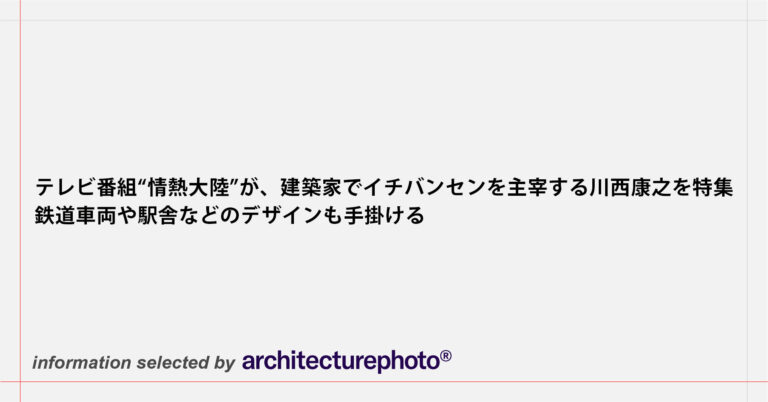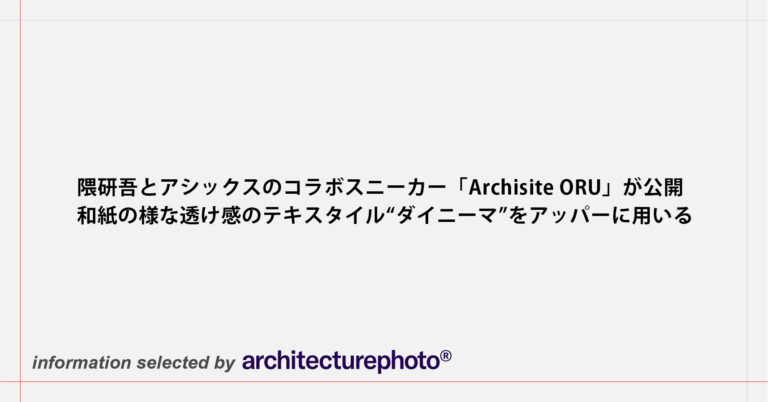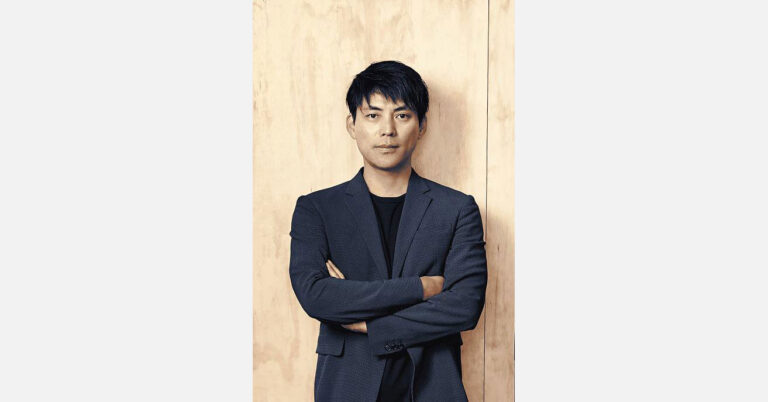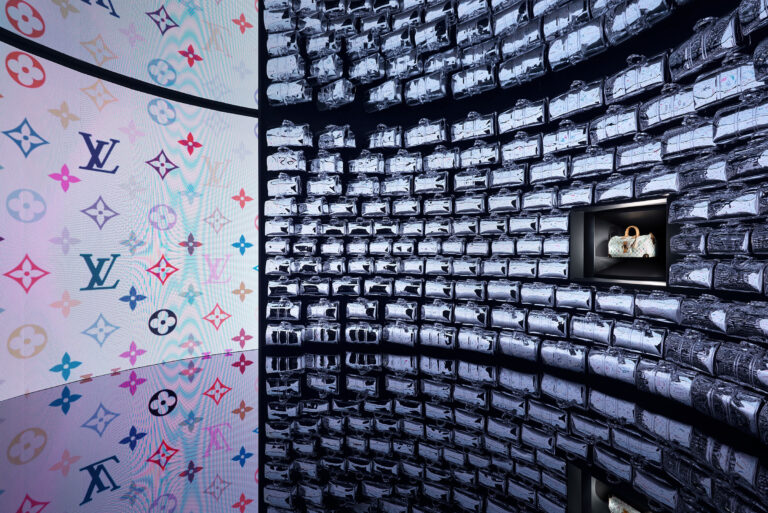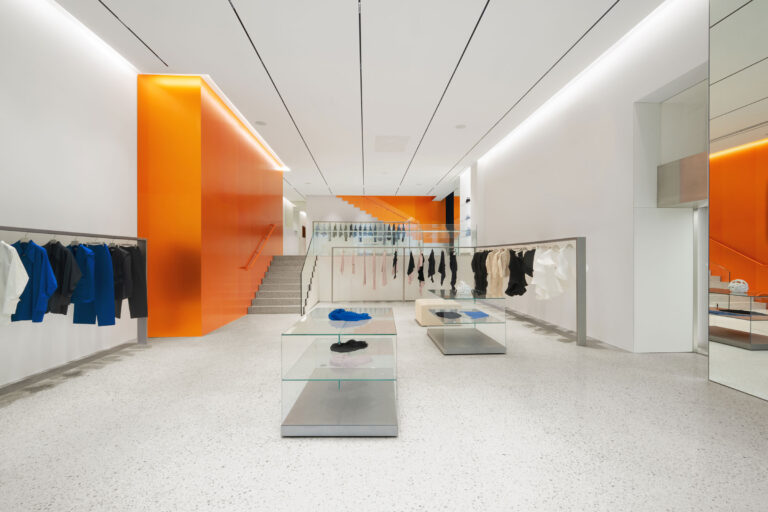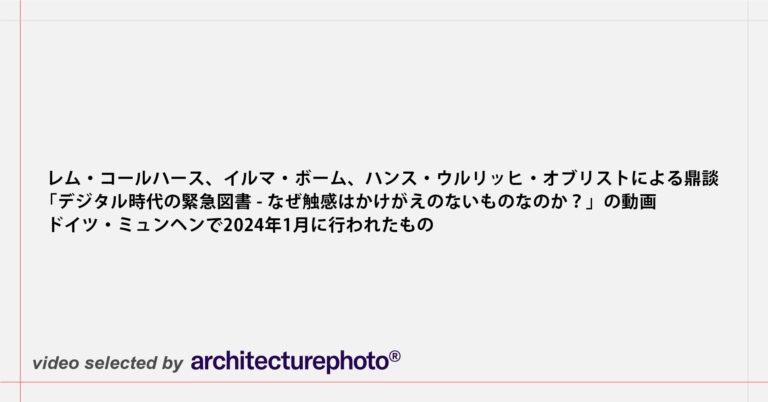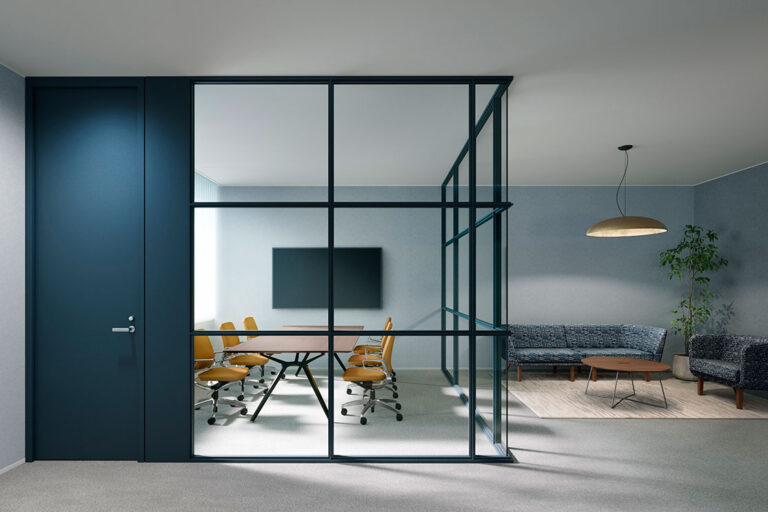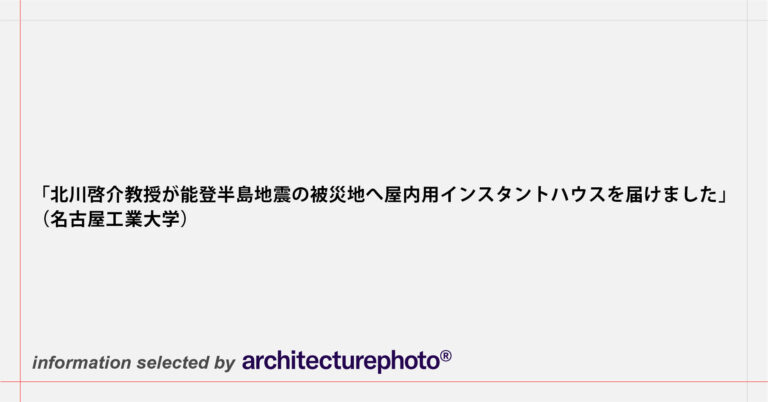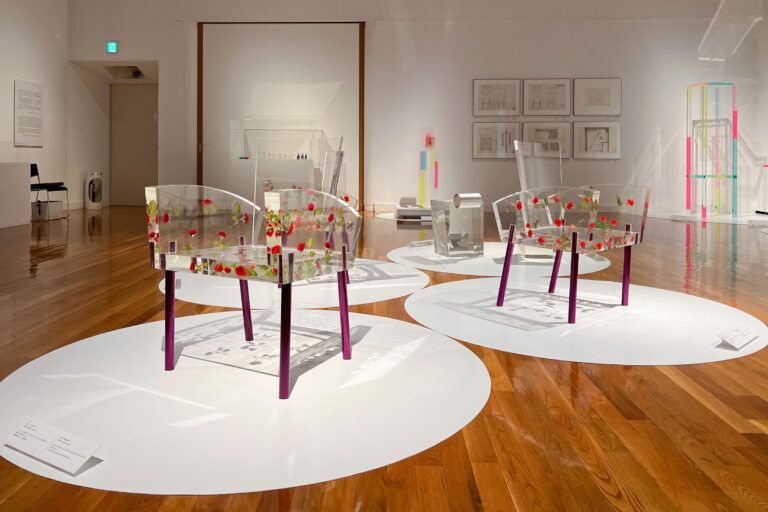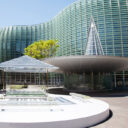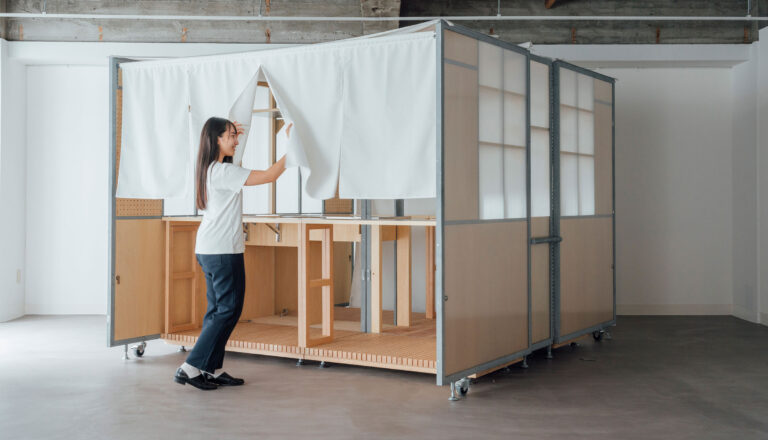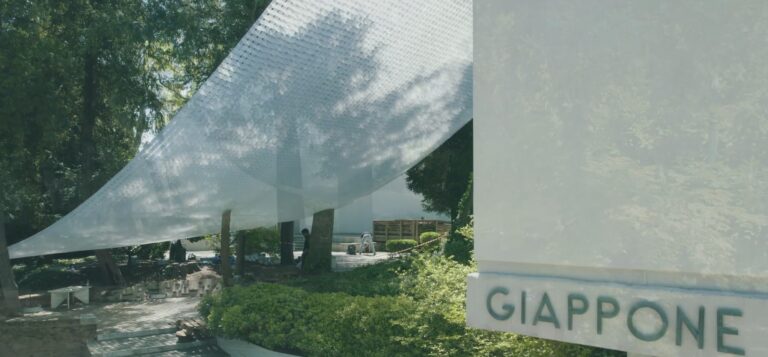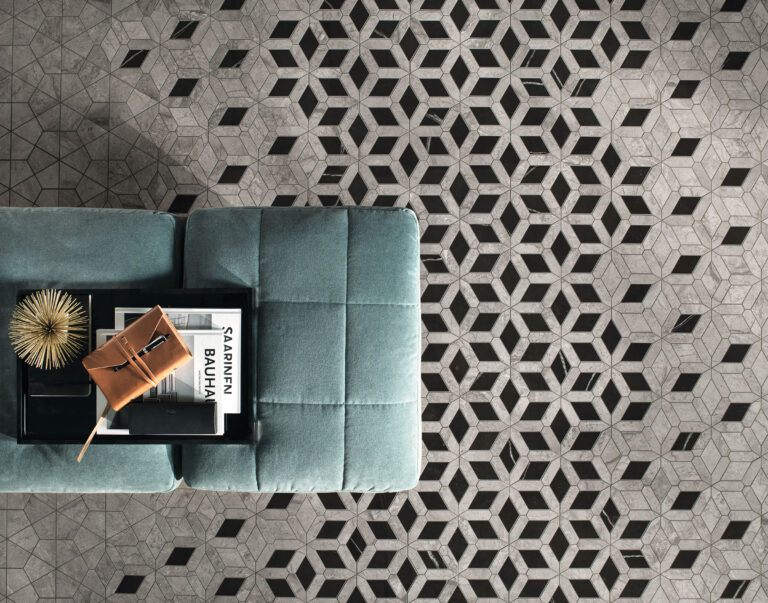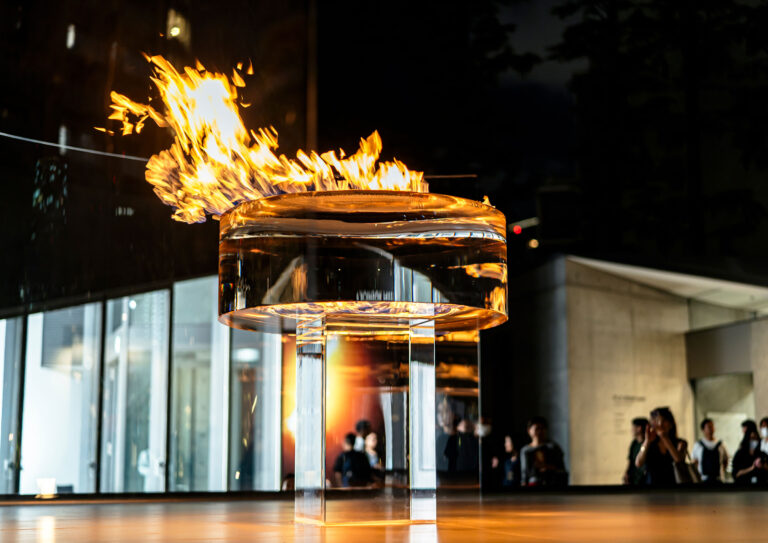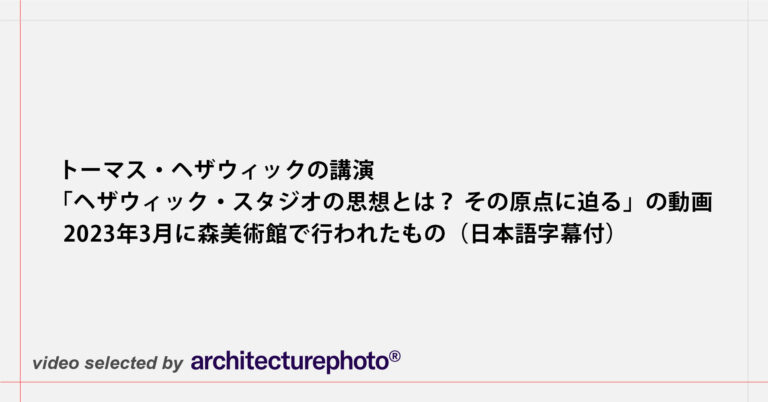テレビ番組“情熱大陸”が、建築家でイチバンセンを主宰する川西康之を特集します。鉄道車両や駅舎などのデザインも手掛けています。放送日は、2024年4月14日。リンク先に予告動画も掲載されています。アーキテクチャーフォトでは川西の作品をこれまでに二作品紹介しています。
design archive

重松象平が「2023毎日デザイン賞」を受賞しています。
クリスチャン・ディオール展の空間デザインや、虎ノ門ヒルズステーションタワーの建築デザインで評価されました。
毎日デザイン賞とは
グラフィックやインテリア、クラフト、ファッション、建築など、あらゆるデザイン活動で、年間を通じて優れた作品を制作、発表し、デザイン界に大きく寄与した個人、グループ、団体を顕彰する賞です。(主催・毎日新聞社)
1955年に毎日産業デザイン賞として創設され、デザインの多様化を背景に76年に毎日デザイン賞と名称を変更した後も我が国のデザインの活性化とともに歩み続けています。国際的、文化的な賞として高い評価を受けています。
選考委員(50音順・敬称略)
齋藤精一(パノラマティクス主宰)/柴田文江(プロダクトデザイナー)/須藤玲子(テキスタイルデザイナー)/永井一史(アートディレクター)/保坂健二朗(滋賀県立美術館ディレクター(館長)
重松氏はニューヨークを拠点に世界各地で活躍している、今最も注目される建築家の一人。
2022年12月から翌年5月に日本で開催された「クリスチャン・ディオール、夢のクチュリエ」展では、その空間デザインを担当。日本の地域性を反映させ、ディオールの世界観を読み解いた幻想的でダイナミックな空間は没入感に満ち、多くの人々を魅了して絶大な人気を博した。
また、「虎ノ門ヒルズステーションタワー」(23年10月開業)では、建築デザインを担当し、メトロ新駅直結の駅前広場が一体的に作られ、地下2階から3層にわたっての吹き抜けの大空間や、タワーの最上階にはホールやギャラリーを備えた情報発信拠点「TOKYO NODE」を設けるなど、都市再生の新しいかたちを壮大なスケールで実現した。
現在も「江戸東京博物館」の空間デザインなど複数のプロジェクトが進行中で、今後の活躍にますます期待が高まる。
以下に、評価の対象となった作品の写真も掲載します。



OMA / 重松象平が空間デザインを手掛けた、タイ・バンコクでの展覧会「ヴィジョナリー・ジャーニーズ」です。
ルイ・ヴィトンの“物語”を伝える為の展示です。建築家は、直観的に発見し吸収できる“物語装置”として、過去と現代の作品を再文脈化した舞台芸術的な体験を構築しました。そして、製品や背景からインスパイアされた5つのテーマルームを作りました。
以下はリリーステキストの翻訳です
OMA/重松象平が、バンコクでのルイ・ヴィトンのための展覧会「ヴィジョナリー・ジャーニーズ」の開催を発表
ヴィジョナリー・ジャーニーズは、ヴィジョナリー・ジャーニー展のコンセプトに関する建築的アイデンティティをOMA/重松昌平とルイ・ヴィトンが共同で手掛けるパートナーシップの最初の作品です。
バンコク、2024年2月28日───バンコクのゲイソーン・アマリンの地上階に位置する「LVザ・プレイス・バンコク」の文化的要素として、初プロジェクトが一般公開されます。それは、展示、カフェ、ストア、レストランを統合したルイ・ヴィトンの新しいインターフェースです。パートナーの重松象平とプロジェクト・アーキテクトのジェシー・カタラーノが率いるこの展示戦略は、メゾンの柱である「サヴォアフェール」「イノベーション」「クリエイティビティ」を反映した夢のような環境を通して、歴史的作品と現代作品を再文脈化し、舞台芸術的な体験を構築するものです。
OMAパートナーの重松象平は言います。「私は、ピエトロ・ベッカーリや彼のチームと協力し、ルイ・ヴイトンの旅の次の章のために、新しい展覧会の舞台美術に貢献できることに興奮しています。私たちは、メゾンのDNAの最も基本的な要素を掘り起こし、コンテンツの物理的、非物質的なクオリティを反映したテーマに沿った部屋を作りました。建築は、それぞれのテーマの背後にある物語を直感的に発見し、吸収するよう、見る者を誘う物語装置となります」
メゾンの最も特徴的なデザインや瞬間は、それらを含む環境に変換されます。5つのテーマルーム「トランクスケープ」「オリジン」「アイコニック・バッグ」「コラボレーション」「スーベニア」は、その内容から得た特定の展示タイポロジーを用いて構成されています。構造の革新、果てしないアーカイブの形式、素材の質、イコノグラフィーなどの要素やテクニックが抽出され、各部屋の新しいパーツのキットに翻訳されます。
「トランクスケープ」は、ルイ・ヴィトンのストーリーの始まりを、ブランドの核となるクラフトマンシップと革新の歴史を象徴する代表的な製品、トランク「クーリエ・ロジーヌ90」を用いて構築されたインスタレーションで表現しています。トランクは安定感を体現しているが、私たちはそれを不安定にして新しい環境を構想しています。96個のトランクがアーチ状に組み合わされ、構造的な完全性、強度、そして同時に軽さを示しています。独創的で上質な構造を際立たせるトランク・モジュールは、それぞれ本物のパーツで作られています。それは、ウッド、ルイ・ヴィトンのアイコンであるモノグラム・キャンバス、そして本物のメタリック・ディテールです。特注の金属製リングがユニットを目立たないように固定します。その結果、トランクスケープはスクリーンに囲まれ、ストーリーテリングのためのサーフェイスを広げ、観客を展覧会への魅惑的な入り口へといざないます。



吉岡徳仁がデザインした、フランス・パリの、イッセイ ミヤケの新旗艦店です。
19世紀に建てられた歴史的建築を店舗に改修する計画です。デザイナーは、ブランドのものづくりの哲学と未来へのエネルギーの表現を意図し、“オレンジ色のアルミニウムウォール”を用いた空間を考案しました。また、ミニマルで現代的な美学を反映されました。
19世紀のフランスの歴史的な建築に、太陽を象徴するオレンジが彩られている。
特殊な電解技術により染色された、オレンジ色のアルミニウムウォールの空間には、イッセイ ミヤケのものづくりのフィロソフィーと、未来へのエネルギーが表現されている。
レム・コールハース、イルマ・ボーム、ハンス・ウルリッヒ・オブリストによる鼎談「デジタル時代の緊急図書 – なぜ触感はかけがえのないものなのか?(Urgent Books in the Digital Age – Why the Tactile Experience Is Irreplaceable)」の動画です。DLDというイベントの一環としてドイツ・ミュンヘンで2024年1月に行われたものです。イベントの公式ページはこちら。



成瀬・猪熊建築設計事務所がデザイン監修した「common furniture / Partition(コモンファニチャー パーティション)」です。
メーカーとコラボした事務所等の為のパーティションです。建築家は、現代の“多様な働き方を可能にする空間”に応える為、様々なフレーム・パネル・カラーから組合せ可能な製品を考案しました。また、飲食や物販の商空間でも使える意匠性も意図されました。製品の公式ページはこちら。
イトーキとコラボレーションし、common furniture / Partitionというハイパーティションシリーズの監修を行いました。
以前に監修した家具のシリーズcommon furnitureに、パーティションが加わった形になります。
common furniture / Partitionは、長年使い続けてきたオフィスパーティションのデザインやシステムを部分的に見直し、その価値を再発見・拡張させたプロダクトです。
オフィスパーティションは、現場での作業時間が短いことに関しては大変優れていますが、デザインには制約がありました。一方で、近年はより多様な働き方を可能にする空間とデザインが求められています。これを実現するため、今回、ディテールを再編集し、より複雑な部材の組み合わせを可能にするとともに、ガラス以外にエキスパンドメタルやパンチングメタルのパネルを挟み込むことを可能にし、カラーや素材感の種類も増やしました。
「北川啓介教授が能登半島地震の被災地へ屋内用インスタントハウスを届けました」というリリースが名古屋工業大学のウェブサイトに掲載されています。写真も12枚掲載されています。中日新聞のウェブサイトにもニュースとして取り上げられています。

倉俣史朗の世田谷美術館での展覧会「記憶のなかの小宇宙」の入場チケットを、5組10名様にプレゼントいたします。応募締切は2023年12月18日13時まで(お申込みにはGoogleアカウントが必要になります)。厳正な抽選を行い当選された方にはメールにてご連絡いたします(メール送付を当選発表に変えさせていただきます)。アーキテクチャーフォトでは、本展覧会を特集記事として紹介しています。展覧会の公式ページはこちら。
※厳正な抽選を行いまして当選者の方にメールをお送りしました。沢山のご応募誠にありがとうございました。(2023/12/20追記)


吉岡徳仁が主宰する「TOKUJIN YOSHIOKA + TYD」の、空間設計スタッフ(経験者・既卒・2024年新卒)募集のお知らせです。詳しくは、ジョブボードの当該ページにてご確認ください。アーキテクチャーフォトジョブボードには、その他にも、色々な事務所の求人情報が掲載されています。
新規の求人の投稿はこちらからお気軽にお問い合わせください。
吉岡徳仁が率いるデザイン事務所、TOKUJIN YOSHIOKA + TYD(株式会社TYD)では、新たな活動に伴い、スタッフを募集いたします。
■職種:空間設計
・業務内容:ISSEY MIYAKE等の店舗の空間設計、展覧会のインスタレーション、建築の設計など



鈴木知悠 / 地域価値共創センターが設計した「SHOPKIT」です。
街の様々な場の活性化を意図した装置です。建築家は、ビル建替時の遊休地の活用方法への疑問を出発点とし、明るく親しみ易い空間が“即席で立ち上がる”仕組みを考案しました。また、都市の中の自然空間の肯定と個人の振舞の促進も意図されました。
組み立て解体が可能な移動店舗「SHOPKIT」を制作した。
この建築は誰もが店舗を持つことを可能にし、まちのあらゆる場を活性化する装置である。
このプロジェクトは、広島市街地のビル建て替え時の遊休地を、広場として活用する計画から始まった。当初この広場の計画は暫定利用が目的であり、建て替えと同時になくなる想定であった。しかし、多くの資源が火起こし的に用いられることに違和感を覚え、一過的な公共空間から、継続的な仮設空間へと設計方針をシフトし、この移動店舗が設計された。
広島市街地には複数の河川が都心部へ流れ、平和記念公園周辺をはじめ、その沿岸には多くの公園が群集している。人口密集地に豊かな自然空間が存在することは、この都市の大きな魅力である。私たちは、そういった周囲に存在する空間を肯定的に捉え、個人の振る舞いを促進するための装置を設計した。今後は都市空間やまちの営みへと展開し、連鎖的にまちの風景へ参入することを目指している。
直方体の側面部を扉のように開くことで即席で空間が立ち上がる。底面部にキャスターが備えられ、まちのあらゆるシーンで舞台装置のように振る舞いの場を組み上げることができる。木、スチール、ポリカーボネートによるミニマルな素材と寸法は、明るく親しみやすく、まちの風景を阻害することなく溶け込めるよう意図した。
テキスタイルデザイナー森山茜の作品制作に密着したドキュメンタリー動画です。
ヴェネチアビエンナーレ国際建築展2023の日本館での作品制作のプロセスやコメントを収録しています。動画の制作は岩本健太映像制作事務所。アーキテクチャーフォトでは、日本館の様子を特集記事として掲載しています。
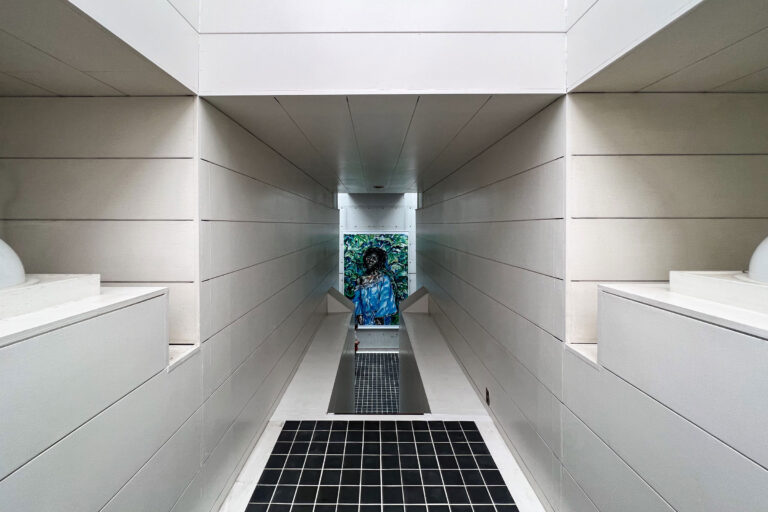
SHARE 原広司による神奈川・多摩区の“粟津邸”で、Karimoku New Standardの展示「Encounters」が開催
- 日程
- 2023年11月5日(日)–11月12日(日)



原広司の設計で1972年に完成した神奈川・多摩区の“粟津邸”で、Karimoku New Standardの展示「Encounters」が開催されます。
会期は2023年11月5日(日)~2023年11月12日。要事前申込。入場無料です。建築の図面やテキストはこちらに掲載されています。
Karimoku New Standard(以下、KNS)は、2023年11月5日(日)から2023年11月12日(日)の間、神奈川県川崎市にある「粟津邸」にて、エキシビション「Encounters」を開催します。粟津邸は、1950年代からグラフィックデザイナーとして活躍した粟津潔の自邸であり、彼と交流のあった建築家の原広司による名作住宅です。1972 年に竣工したこの家の斬新さとアウラは、時代を超えて存在しつづけるもの。そんな空間に、新しいスタンダードを志向するKNS の家具がここでしか見られない風景をつくります。
粟津邸は、粟津が家族と暮らす住まいであるとともに、制作の場であり、友人たちが訪れるサロンであり、ここで多くの人が「出会い」、
その交流からさらに新しい仕事が次々と生まれました。KNSもまた、こうした粟津邸のあり方に通じるものがあります。KNSは2009年の
発足以来、多くの「出会い」とコミュニケーションを積み重ね成長してきたブランドです。国内外の新世代のデザイナーが持つ先進的
なアイディアと、木製家具に対する卓越した知見を持つカリモク家具のコミュニケーションによって、多様にして優れたアイテムの数々を
生み出してきました。「出会い」を共通点とする粟津邸とKNS。今回のエキシビションでは、両者が「出会い」、新たな可能性を探究します。3 層にわたる各
階には約50 点にも及ぶKNS の製品を展示し、KNSと縁のある作家を中心としたアート作品と共に空間ごとにレイアウトされます。多様
なクリエイションがミックスされた様子から、かつてこの家で生まれた数えきれないほどの出会いにも思いを馳せることができるでしょう。
以下に、申込先の情報と「吉國元展:根拠地」開催時の粟津邸の写真を掲載します。



ザハ・ハディド・アーキテクツによる、モザイク装飾「ダイヤモンド」です。
イタリアのアトラス・コンコルド社の為に開発されました。建築家は、12世紀のモザイク模様を参照しつつ、独自のアルゴリズムを開発して古典的な模様に“破壊的な要素”を取入れる意匠を考案しました。また、表面で空間の性質を定義する可能性も追求されました。
こちらはリリーステキストの翻訳です
アトラス・コンコルドは、チェルサイエ2023にて、新しいマーベル・メラヴィリア・コレクションとザハ・ハディド・アーキテクツとのコラボレーションを発表します。
ワンダーあるいはイタリア語で「メラヴィリア」は、創造性とインスピレーションを駆り立てます。アトラス・コンコルドの新しいマーヴェル・メラヴィリア・コレクションは、カラカッタ・メラヴィリアにちなんで名付けられました。カラカッタ・メラヴィリアは、細長い脈と柔らかな織り目で構成された純白が特徴のタイムレスな大理石です。カラカッタ・ベルニーニ、シルバー・マジェスティック、ブラック・オリジンなど、最高級の大理石を使用したニュートラルな色合いのコレクションは、それぞれの大理石の自然な趣きや 目が活かされており、屋内でも屋外でも使用できるよう、さまざまな仕上げと仕様が用意されています。
ザハ・ハディド・アーキテクツ(ZHA)は、マーベル・メラヴィリア・コレクションに特注のデコラティブラインを提供しました。それは、伝統的なモザイクパターンを再解釈して変化をコンセプトにした「ダイヤモンド」と名付けられたユニークな装飾の数々です。
12~13世紀のローマのコスメッツ・モザイクに含まれる大理石とガラスの複雑な幾何学模様のはめ込みにインスパイアされたZHAの「ダイヤモンド」モザイク装飾は、もはや幾何学模様と色の絶え間ない繰り返しではなく、むしろ進化を遂げています。
ZHAがこのコレクションのために開発したアルゴリズムによって定義されたモザイクの硬質な幾何学模様は、壁や床の表面にわたって展開するにつれて色の構成が変容を遂げ、デザイナーやプランナーが特定のスペースに注意を向けたり、ユニークなデザインでエリアを特徴づけたり、表面によって空間の性質を定義したりすることを可能にします。
ZHAのプロジェクト・ディレクター、パオロ・ジッリは次のように説明します。
「アトラス・コンコルドとのコラボレーションは、古典的なモザイク模様に破壊的な要素を取り入れたデザインにつながりました。ダイヤモンドの中のインクルージョン(内包物)のように、結晶構造の中に新しい要素が挿入されることで、厳格な幾何学模様の繰り返しに予期せぬダイナミズムが生まれます。モザイク装飾のデザインに新たな論理を導入することで、ある色から別の色へと変化するにつれ、タイルのジオメトリーに変容を促します」


吉岡徳仁がデザインした「ガラスの炬火台」と「ガラスのトーチ」です。
2024年の国民スポーツ大会のセレモニーの為に制作されました。デザイナーは、炎から放たれる“光”に着目し、透明なガラスの造形から生み出されたプロダクトです。これらの作品は、21_21 DESIGN SIGHTギャラリー3にて、2023年11月5日まで展示中。展覧会の公式ページはこちら。また、2023年10月7日・28日には実際に火を灯すイベントも行われます(詳細は記事末尾に掲載)。
※イベントが2023年11月3日にも行われるとのことです(2023/10/29追記)
デザインや建築、アートの領域で国際的に活動する吉岡徳仁。形の概念を超える「光」を素材とし、透明感のある独自の表現で作品を生み出してきました。TOKYO 2020オリンピックでは、桜をモチーフにした「聖火リレートーチ」のデザインが大きな話題となりました。
本展では、炎から放たれる「光」に着目し、新作「ガラスのトーチ」と「炎のモニュメント−ガラスの炬火台」を発表いたします。世界でも類を見ない、透明なガラスの造形から生み出された、このトーチとモニュメントは、2024年に開催される、国民スポーツ大会(旧国体)SAGA2024のセレモニーに向けて制作されたものです。
また、吉岡の代表作であるガラスのベンチ「Water Block」をはじめ、MIYAKE DESIGN STUDIOが炎を灯すセレモニーのために手がけた衣服が展示されるほか、会期中には、屋外に設置された「炎のモニュメント−ガラスの炬火台」に火を灯す特別なイベントを開催いたします。これまでに体験したことのない光の世界を創造します。
トーマス・ヘザウィックの講演「ヘザウィック・スタジオの思想とは? その原点に迫る」の動画です。2023年3月に森美術館で行われたものです。日本語字幕付です。また、アーキテクチャーフォトでは、森美術館で行われたヘザウィック展を特集記事として公開しています。
森美術館「ヘザウィック・スタジオ展:共感する建築」ラーニング・プログラム
トーク「ヘザウィック・スタジオの思想とは? その原点に迫る」世界が最も注目するデザイン集団であるヘザウィック・スタジオ。創設者のトーマス・ヘザウィックを招き、世界各地で行ってきたこれまでの革新的なプロジェクトを辿りながら、そのデザインの原点に迫ります。
出演:トーマス・ヘザウィック(ヘザウィック・スタジオ創設者)
聞き手:片岡真実(森美術館館長/「ヘザウィック・スタジオ展:共感する建築」キュレーター)

